NPCA Goes To Cuba! Part IV
Early on Sunday, those of us up for another long drive, left Villa Clara to visit the Che Monument. It was really our first opportunity to see the countryside of Cuba, and this region of the island is quite beautiful with soft green hillsides and rolling land. What struck this Midwest farm boy was the nearly total lack of cultivated land. We learned later in the week that less than 30% of the country’s land is used for farming. Cuba imports about 80% of its food which makes it vulnerable to price increases, changes in food supply and the impacts of natural disasters, i.e., hurricanes.
Most of this situation (if not all) is due to the dependence on Russia and then the end of the cold war and the collapse of the Soviet Union. How Cubans live today in rural Cuba is obvious from just this photo. It is a photo that could have been taken almost anywhere on our two-hour bus ride across the interior.
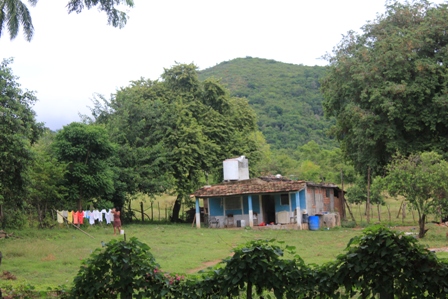
This hard scrabble existence is made more obvious when one sees how little farm equipment is available, all of it from the days of the Soviet Union. Here and there I would spot a trackor in a field or parked and abandoned beside a farm building.
![]()
What land that is being plowed is being done the way most of us saw land cultivated during our Peace Corps tours.
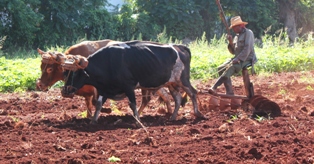
There are bright spots, however. Later in the week, in the suburbs of Havana, we went to see Cuba’s largest urban garden in the housing complex, Alamar. In 2008, Raul Castro allowed private farmers and co-operatives to lease unused land. This ‘decentralized’ decision also meant that farmers could sell directly to consumers. By allowing for ‘urban gardens’ neighborhood collectives could turn vacant lots into farm land. As the head of the Alamar urban garden told us, if this hadn’t happened after the Russian pulled out of Cuba, they would have all starved to death. There are now, according to him, about 2000 such urban gardens in Cuba. Here are few photos of what we saw at one of them.
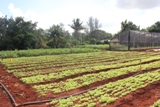
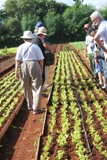
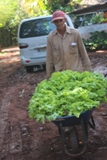
Thank you, John, for sharing the Cuba experience with us. I’ve never been, but I do appreciate your descriptions. Allen
John, have enjoyed your travelogue through Cuba. It’s provided me with a lot of nostalgia, as I also have traversed the island and visited out-of-the-way places. The rural areas remind me of rural areas in Honduras, my Peace Corps country. Cuba seems not to have changed all that much, except perhaps in Havana, since I was last in Cuba in 1997, when State Security interrogated me and kicked me out. Not only do I have that on my record, but 2 Cubans to whom I recently gave copies of my “Confessions” book, after assurances that they had a way of getting it safely into the country, later conveyed messages that the book had been confiscated at the Havana airport. So, I guess if I live long enough, I’ll have to wait until after the Castro brothers have gone to Marxist heaven before I can attempt to return there. You are fortunate to have been able to make such an extensive tour.
However, according to my information, Cuba imports 80%, not 60%, of its food (including sugar from the the DR now), when it imported a maximum of 30% before Fidel and never sugar. Who can forget Fidel Castro’s disastrous 1970 Zafra de los Diez Milliones (Ten Million Ton
Sugar Harvest)? Collective farming has not worked very well anywhere. Now the Cuban government is encouraging the formation of agricultural cooperatives whose members have a little more autonomy.
I just had another Cuba commentary come out in the Huffington Post, the other side of the coin, you might say, to the benign images appearing in your report. http://www.huffingtonpost. com/barbara-e-joe/remembrance- the-death-in-_b_8412032.html
I’m also sure you folks did not see the Ladies in White and other peaceful dissidents being beaten up and dragged away by security forces, as has been occurring during your visit. Nor did you hear about the release last week, after worldwide appeals, of a hunger striking young performance artist, El Sexto, one of our Amnesty International prisoners of conscience (I am volunteer Caribbean coordinator for AI USA) . He was held without charge for 10 months and in solitary confinement for painting the names Fidel and Raul on 2 piglets (inspired by “Animal Farm,” a banned book in Cuba), animals never released, as he was arrested first, probably on an informant’s tip. Of course, the Cuban leadership might point to unsavory events occurring here in the US, such as the black girl being physically attacked by a school security officer for not putting away her cell phone as ordered. The difference here is that the officer was fired and news of the incident was hardly hushed up nor had it been ordered at the highest levels.
Thanks again John for these insights–sad to see the limited support farmers get and the low level of technology.
I’m still hoping to learn of the plight of writers. I remember the impact Ry Cooder had on music when he brought together some of the best old timers and recorded what became the “Buena Vista Social Club” and they eventually performed in Carnegie Hall.
But nothing similar in the area of literature from what I can tell.
Cheers,
Mark